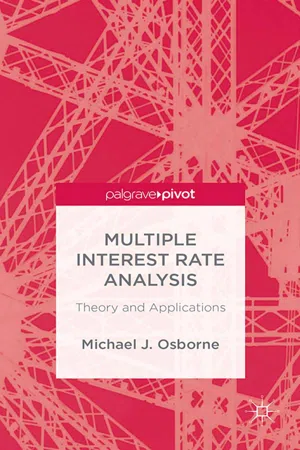Business
IRR Pitfalls
IRR, or internal rate of return, can be a valuable tool for evaluating investment opportunities, but it has some potential pitfalls. These include the assumption of reinvestment at the IRR, which may not reflect real-world conditions, and the potential for multiple IRRs in complex cash flow patterns. Additionally, IRR may not account for the scale of investments or the timing of cash flows.
Written by Perlego with AI-assistance
Related key terms
1 of 5
6 Key excerpts on "IRR Pitfalls"
- eBook - ePub
Multiple Interest Rate Analysis
Theory and Applications
- M. Osborne(Author)
- 2014(Publication Date)
- Palgrave Pivot(Publisher)
(2004). Many studies of capital budgeting practice are published every year containing similar results for various countries. In the context of IRR as a performance measure for private equity firms, hedge funds, and venture capitalists see the works by Phalippou (2008), Phalippou and Gottschalg (2009), Dichev and Yu (2011), and Achleitner et al. (2013). In the context of public-private partnerships (PPPs), the UK government counsels caution about the use of IRR to appraise public investment projects (HM Treasury 2004), yet the practice continues with unfortunate consequences for education and health care (see, for example, Cuthbert and Cuthbert, 2012). Why do so many practitioners fail to heed academic advice? One possible reason is that they do not find the advice persuasive. This chapter employs multiple-interest-rate analysis to demonstrate that the IRR Pitfalls do not provide convincing arguments. A new dual expression for NPV is derived supporting the arguments begun in Osborne (2010a) that the second and third pitfalls are inadequate, and therefore finance textbooks describing the pitfalls should be revised. The analysis goes on to introduce a quantum of value as an analytical device enabling the new dual expression to demonstrate why the fourth IRR pitfall concerning non-flat yield curves is also inadequate. Finally, a more convincing reason than the IRR Pitfalls to prefer NPV is provided by the new dual expression itself: a project’s NPV possesses meaningful information additional to that possessed by its IRR. The chapter concludes with two annexes. The first annex contains numerical examples of the new dual expression coping with various types of unconventional cash flows. The second annex contains a case study of multiple-interest-rate analysis applied to public-private partnerships (PPP) - eBook - PDF
- Robert Parrino, David S. Kidwell, Thomas Bates(Authors)
- 2016(Publication Date)
- Wiley(Publisher)
The payback period is the length of time it will take for the cash flows from a project to recover the cost of the THE FUNDAMENTALS OF CAPITAL BUDGETING 356 5. Be able to compute the internal rate of return (IRR) for a capital project, and discuss the conditions under which the IRR technique and the NPV technique produce differ-ent results. The IRR is the expected rate of return for an investment project; it is calculated as the discount rate that equates the present value of a project’s expected cash inflows to the present value of the project’s outflows – in other words, as the discount rate at which the NPV is equal to zero. Calculations are shown in Section 10.5 and Learning by Doing Application 10.3. If a project’s IRR is greater than the required rate of return, the cost of capital, the project is accepted. The IRR rule often gives the same investment decision for a project as the NPV rule. However, the IRR method does have operational pitfalls that can lead to incorrect decisions. Specifically, when a project’s cash flows are unconventional, the IRR calculation may yield no solution or more than one IRR. In addition, the IRR technique cannot be used to rank projects that are mutually exclusive because the project with the highest IRR may not be the project that would add the greatest value to the firm if accepted – that is, the project with the highest NPV. 6. Explain the benefits of a post-audit review of a capital project. Post-audit reviews of capital projects allow management to determine whether the project’s goals were met and to quantify the benefits or costs of the project. By conducting these reviews, managers can avoid similar mistakes and possibly better recognise opportunities. - eBook - PDF
- Aswath Damodaran(Author)
- 2014(Publication Date)
- Wiley(Publisher)
IN PRACTICE: M ULTIPLE IRR S : W HY T HEY E XIST AND W HAT TO DO ABOUT T HEM The IRR can be viewed mathematically as a root to the present value equation for cash flows. In the conventional project, where there is an initial investment and positive cash flows thereafter, there is only one sign change in the cash flows, and one root— i.e., there is a unique IRR. When there is more than one sign change in the cash flows, there will be more than one IRR. 11 In the project just assessed, for example, the cash flow changes sign from negative to positive in year 1, and from positive to negative in year 4, leading to two IRRs. 11 Although the number of IRRs will be equal to the number of sign changes, some IRRs may be so far out of the realm of the ordinary (e.g., 10,000%) that they may not create the kinds of problems described here. Probabilistic Approaches to Investment Analysis 209 Lest this be viewed as some strange artifact that is unlikely to happen in the real world, note that many long-term projects require substantial reinvestment at intermediate points in the project and that these reinvestments may cause the cash flows in those years to become negative. When this happens, the IRR approach may run into trouble. There are a number of solutions suggested to the multiple IRR problems. One is to use the hurdle rate to bring the negative cash flows from intermediate periods back to the present. Another is to construct an NPV profile. In either case, it is probably much simpler to estimate and use the NPV. ◾ P ROBABILISTIC A PPROACHES TO I NVESTMENT A NALYSIS In all of the approaches that we described in the last section—accounting returns, payback, NPV, and IRR—we used earnings or cash flows that were estimated for future years for the projects that we were analyzing. While we use expected values for revenues, margins and other key variables, the future is uncertain and the estimates will therefore reflect that uncertainty. - eBook - PDF
Corporate Finance
Theory and Practice in Emerging Economies
- Sunil Mahajan(Author)
- 2020(Publication Date)
- Cambridge University Press(Publisher)
A few years later, the project has been completely shelved and the company no longer manufactures the Nano car. An assessment of risks inherent in a project can, therefore, be extremely useful. Internal rate of return provides an idea of the margin of safety and, therefore, of the risk inherent in the project which the NPV methodology cannot do. Similarly, PI reveals the value addition per unit of investment which is not only a useful parameter to know but also indicates the level of risk. Let us assume that an evaluation of a project yields an NPV of ₹0.50 billion. How risky is the project? It is difficult to figure out with only the NPV figure. However, an IRR of 20 per cent and the COC equalling 12 per cent tell us there is sufficient leeway for cash flows to decline without making the project unviable. Similar will be the case with a PI of 1.8. Project evaluation with more varied criteria is likely to give the management a better grip on risk assessment and hopefully improve decision-making in an area that is fraught with significant level of risk. Capital Budgeting | 105 Advances in Computational Capabilities Many aspects which we have discussed, including the comparisons made amongst the different methods of capital budgeting, have over the years become redundant due to the development of computing techniques and capabilities. In the pre-computer days, calculating IRR and NPV used to be a tedious task. Estimation of IRR was in fact particularly tough, being an iterative process. Sitting down with long-term cash flows, a calculator in hand, punching figures therein, may present a rather romantic picture now but was not a very pretty sight in those times. Besides the time and effort involved, there were significantly high possibilities of committing an error. Imagine taking up a project only due to a calculation error and later discovering that the project actually destroys value. Simplicity in figures and calculation commanded a premium. - eBook - ePub
Finance
Capital Markets, Financial Management, and Investment Management
- Frank J. Fabozzi, Pamela Peterson Drake(Authors)
- 2009(Publication Date)
- Wiley(Publisher)
The index value is greater than one, which means that the investment produces more in terms of benefits than costs. An advantage of using the profitability index is that it translates the dollar amount of NPV into an indexed value, providing a measure of the benefit per dollar investment. This is helpful in ranking projects in cases in which the capital budget is limited.The decision rule for the profitability index depends on the PI relative to 1.0, which meansINTERNAL RATE OF RETURN
Suppose an investment opportunity requires an initial investment of $1 million and has expected cash inflows of $0.6 million after one year and another $0.6 million after two years. This opportunity is shown in Figure 14.3 using a time line.The return on this investment (denoted by internal rate of return or IRR, in the next equation) is the discount rate that causes the present values of the $0.6 million cash inflows to equal the present value of the $1 million cash outflow, calculated asAnother way to look at this is to consider the investment’s cash flows discounted at the IRR of 10%. The NPV of this project if the discount rate is 13.0662% (the IRR in this example), is zero:An investment’s internal rate of return is the discount rate that makes the present value of all expected future cash flows equal to zero. We can represent the IRR as the rate that solves Going back to Project X, the IRR for this project is the discount rate that solves Using a calculator or a computer, we get the answer of 10.172% per year.FIGURE 14.3Timeline of Investment OpportunityLooking back at the investment profiles of Projects X and Y, each profile crosses the horizontal axis (where NPV = 0) at the discount rate that corresponds to the investment’s IRR. This is no coincidence: by definition, the IRR is the discount rate that causes the project’s NPV to equal zero.The IRR is a yield—what is earned, on average, per year. How do you use it to decide which investment, if any, to choose? Let’s revisit Projects X and Y and the IRRs we just calculated for each. If, for similar risk investments, owners earn 10% per year, then both Projects X and Y are attractive. They both yield more than the rate owners require for the level of risk of these two investments: - eBook - PDF
Microeconomics
A Global Text
- Judy Whitehead(Author)
- 2020(Publication Date)
- Routledge(Publisher)
16.4.2.4 APPLICATION OF THE IRR CRITERION – PROJECT SELECTION AND RANKING FOR MULTIPLE PROJECTS For multiple projects, all projects with IRR higher than the hurdle rate are ranked for selection. The criteria for selection would be as follows: • Assign the highest rank (highest priority for selection) to the project with the highest IRR above the hurdle rate. • Set out the original cash investment outlay for each project on the list of acceptable projects. • Select, from the highest ranked downwards on the priority list, as many projects in the rank order such that the total cash available for investment in the projects is not exceeded. 16.4.2.5 PROBLEMS OR CAUTIONS WITH THE USE OF THE IRR There are some problems which afflict the IRR and tend to moderate its use as an investment decision tool. These include the following. C H A P T E R 16 479 INVESTMENT CRITERIA C H A P T E R 16 BOX 16.2 COMPUTATION OF INTERNAL RATE OF RETURN – AN EXAMPLE Consider a proposed project that has a life of two time periods (years) beyond the original investment period. The original investment is $100.00. This gives ( β 0 ) = − $100 and has a negative value since the initial investment represents an outflow of funds (cost). The net benefits ( β t ) over the two years ( t = 1, 2) may be set out as follows: Year 1 Year 2 Net benefit stream $0.00 ( = β 1 ) $115.00 ( = β 2 ) The investing firm/individual has determined that the appropriate hurdle rate is 5 per cent ( r = 0.05). Applying the IRR formula for the initial investment time period ( t = 0) plus two additional time periods ( t = 1, 2), the IRR is computed as: 2 0 β t = 0 r ) t t = 0 (1 + or: β 0 β 1 β 2 + + = 0 (1 + r ) 0 (1 + r ) 1 (1 + r ) 2 This becomes: − $100 $0 $115 + + = 0 . (1 + r ) 0 (1 + r ) 1 (1 + r ) 2 Thus, for this project the IRR is: IRR = 7 . 23% With a hurdle rate of 5 per cent, the computed IRR of 7.23 per cent means that the project is acceptable.
Index pages curate the most relevant extracts from our library of academic textbooks. They’ve been created using an in-house natural language model (NLM), each adding context and meaning to key research topics.





